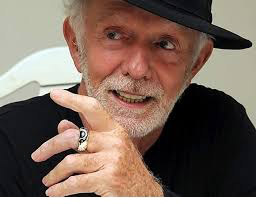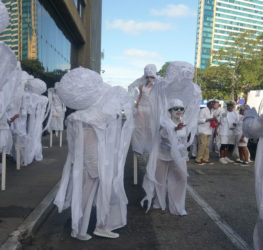Gaping mouths and ghastly sockets scream silently of nothingness, as the phantom heads float high, trailing suckered tentacles in all ghostly white swathes, sardonic symbols of a post-apocalyptic grim world titled “Sailors on an Exotic Isle.” This year’s last minute Carnival creation of genius designer and veteran mas-maker, Peter Minshall, entirely hand-sewn from simple chicken wire, glue and plain cloth, “Spiritus Mundi” is a Latin term that means “Spirit” or “State of the World.”

Inspired by “The Second Coming” composed by Irish poet, William Butler Yeats nearly a century ago following the devastation and violence of World War One, “Spiritus Mundi” is a profound commentary on the post nuclear destiny that increasingly seems to await us.

“A classic robber mas and a classic sailor mas morphed as one to make an ominous, empty, vaporised future, appear before us as a passing parade in the present Carnival 2017. You can’t play mas and ‘fraid powder,” the band’s internet profile warned. Mas is the country’s abbreviation for its masquerade tradition.
Developed with acclaimed jazz musician, Etienne Charles and friends, the band grew out of a sudden visit led by Peter Samuel, Minshall’s close friend and King of Carnival, who reigned exclusively as the mas maestro’s choice player in his finest stage installations that saw the pair winning eight titles each with “Minsh” copping multiple Band of the Year awards ranging from the pioneering Paradise Lost in 1976 to The Sacred Heart in 2006.
In 2016 after a ten-year hiatus, Minshall returned to mas with his jaw-dropping “Dying Swan, Ras Nijinsky in Drag as Pavlova,” a riveting androgynous art work that featured a powerful male “moko jumbie” dressed as a dancing, delicate ballerina en pointe and in drag portrayed by seasoned stilt-walker Jha-Whan Thomas. It placed a controversial third in the King of Carnival finals and was criticized by some for its “minimalistic design.”

A while back, my Trini husband and I ran into the mas maker quietly shopping in a Port-of-Spain supermarket. Hearing that I, too, was from Georgetown, the approachable icon immediately recounted he was delivered in the capital in July, 1941 but conceived in Trinidad. As he would repeat, “I was taken to Guiana in my mother’s womb to be born in the embrace of her loving family, because my parents were in the midst of an ugly divorce. I was brought back to Trinidad in my mother’s arms” years later.
His father, a roving cartoonist and artist, Wilson Minshall, was responsible for the public relations of the Trinidad All Stars Percussion Orchestra (TAPSO) which travelled to the Festival of Britain, in 1951 as the first official steel band to leave the island. Wilson was instrumental in having the word “calypso” chosen as the official description of the popular music that accompanied the indigenous instrument, according to the English Creole Dictionary of Trinidad and Tobago.
Mom, Jean Grant, became the Social Editor of the Trinidad Guardian newspaper. Decades on, in 2013, Minshall would reiterate with his usual candour, in an exchange with the same newspaper: “Marks of adornment are made purely for the purpose of drawing attention, to underline or define the subject, to SHOW the GIRL” adding “The entire Carnival has for 20 years been turned over to women repetitively playing cheap, tawdry, outdated, Las Vegas SHOWGIRL mas, with men mindlessly playing props.” His Trinidad return and teenage years at the premier Queens Royal College (QRC) “gave me an understanding of myself in the world that I could not have got elsewhere.” At 13 he would concoct his first school costume from available scraps of bones, cardboard, dried grass, Christmas ornaments, some silver paint and “two ounces of artist’s charcoal for 43 cents”. It won Minshall’s first prize for originality in Auntie Kay’s Red Cross Kiddies Carnival.
Studying theatre design at the Central School of Art and Design in London he graduated with honours. Long fascinated by drama and a fan of Shakespearean plays, Minshall excelled working on sets and costume design at regional theatres in Britain gaining praise for Sadler’s Wells’ opening of the Scottish Theatre Ballet’s “Beauty and the Beast.” Gradually involved with West Indian productions in London, he swept the prizes at the Notting Hill Carnival bringing out four victorious bands.
In 1974 his mother convinced him to design a Trinidad Carnival costume for his adopted sister Sherry-Ann Guy Coelho that would become a sensation and launch the legend. “The Land of the Hummingbird” highlighted Minshall’s trademarks of accuracy, originality, flexibility and movement. The kinetic tour de force took months to materialize, and five weeks of actual painstaking construction by 12 people using 104 ‘feathers’ each one made of 150 different portions cut from a vivid rainbow of fabrics. By 1976 he would follow up with a full-size band in four movements, under the theme “Paradise Lost” inspired by Milton’s epic. The band was conceived in four “movements” like a symphony, and introduced a form of winged costume based on Minshall’s study of the symbolic bat and traditional Carnival characters, which he would continue to develop over the course of his career. As Paradise Lost paraded through the streets of the city, a grand narrative unfolded. High mas would never be the same.
“Two of the most heartfelt experiences I have had in the entirety of my life in the mas, is the one that started it all from the ‘Land of the Hummingbird,’ and the one that took flight and landed last year – ‘the Dying Swan,’ ” he told Newsday in an interview recently. His passion for cloth and consummate skill with it have shone at several Olympics, especially the Barcelona Games even as the giant 16-foot tall puppets Saga Boy and Tan Tan figures, have danced their way into the collective Carnival psyche. He would state: “It is very obvious once you’ve done it, to extend the human spine upwards into the spine of the puppet, to join hands to hands and feet to feet, so puppet and puppeteer move and dance as one. It looks like something that has been done for centuries. But nobody had ever done it before…”
The foremost craftsman of “dancing mobiles” he excels in such performance art that combines the three-dimensional quality of large-scale sculpture with the dramatic and choreographic expressiveness of a live human performer. The “dancing mobile” is one of many forms to grow out of the mas and was the subject of a fellowship to Minshall awarded by the Guggenheim Foundation in 1982, Caranval.com points out.
Among his best bands were Zodiac, Carnival of the Sea, Dance Macabre, and Papillon consisting of 2,500 masqueraders wearing ten-foot butterfly wings in a huge meditation on the ephemeral nature of life. His magnificent River from 1983 began the trilogy of bands that many consider Minshall’s magnum opus. The Queen or “Washerwoman” represented life and purity, the King “Mancrab” a symbol of greed and technological madness. In his metaphorical narrative, these two characters battled over the souls of the River People, depicted by the ordinary masqueraders.
A man always acutely conscious of developments in his homeland and globally, Minshall explained that the 2017 limited sailor mas band “Spiritus Mundi” like “any other self-respecting artform” was about the constant changes and challenges including the widening fallout from the Republican Donald Trump’s polarizing presidency in the United States (U.S).
“The world certainly woke up to a different morning after the last U.S presidential election,” he asserted. Acknowledging that the band was small and could work with “anything from 30-100” the designer declared, “A whisper spoken with earnestness and a sense of truth can be more powerful than a loud explanation that has nothing at its centre nor soul.”
The short timeframe within which he had to work did not allow for a large, elaborate production of say 3 000 individuals. “But, what is wonderful about it is that almost consciously I was combining two of the greatest traditions in the mas ‘the sailor’ which was twinbirthed with pan and in the last 40s and early 50s and ‘the robber’ which has been there since time immemorial.”
In the tumult generated by President Trump, and the threat of ensuing chaos and an upending of established order, Yeats’ “The Second Coming” seems to portend a most frightening future:
Turning and turning in the widening gyre
The falcon cannot hear the falconer;
Things fall apart; the centre cannot hold;
Mere anarchy is loosed upon the world,
The blood-dimmed tide is loosed, and everywhere
The ceremony of innocence is drowned;
The best lack all conviction, while the worst
Are full of passionate intensity.
Surely some revelation is at hand;
Surely the Second Coming is at hand.
The Second Coming! Hardly are those words out
When a vast image out of Spiritus Mundi
Troubles my sight: a waste of desert sand;
A shape with lion body and the head of a man,
A gaze blank and pitiless as the sun,
Is moving its slow thighs, while all about it
Wind shadows of the indignant desert birds.
The darkness drops again but now I know
That twenty centuries of stony sleep
Were vexed to nightmare by a rocking cradle,
And what rough beast, its hour come round at last,
Slouches towards Bethlehem to be born?”
ID applauds Peter Minshall’s belief artists never retire and celebrates his statements that “my entire life’s work has been to lead my tribe into a tumultuous world, into a tremendous cultural battle for the soul” and “to proclaim its glorious name and identity to the world.”





